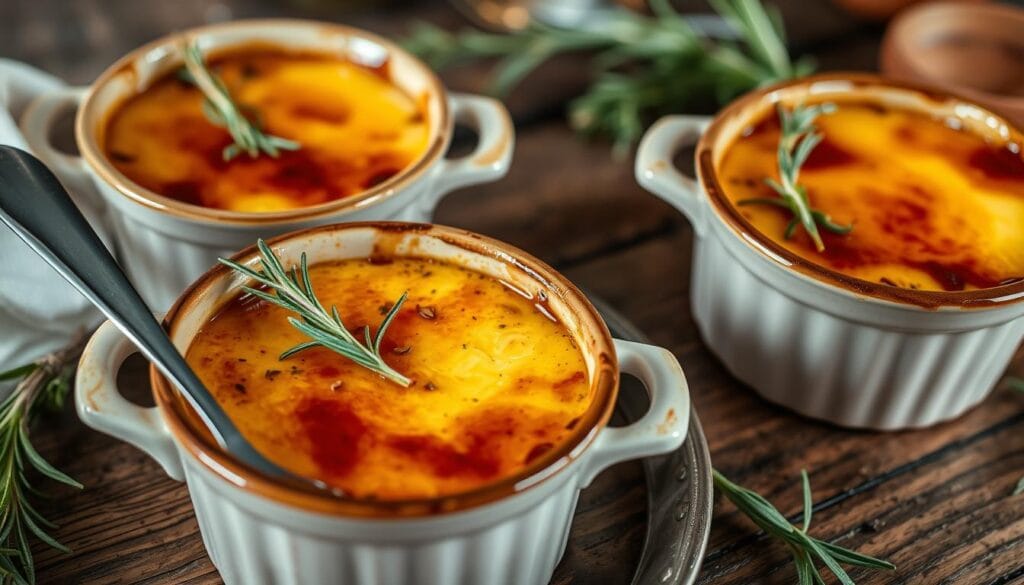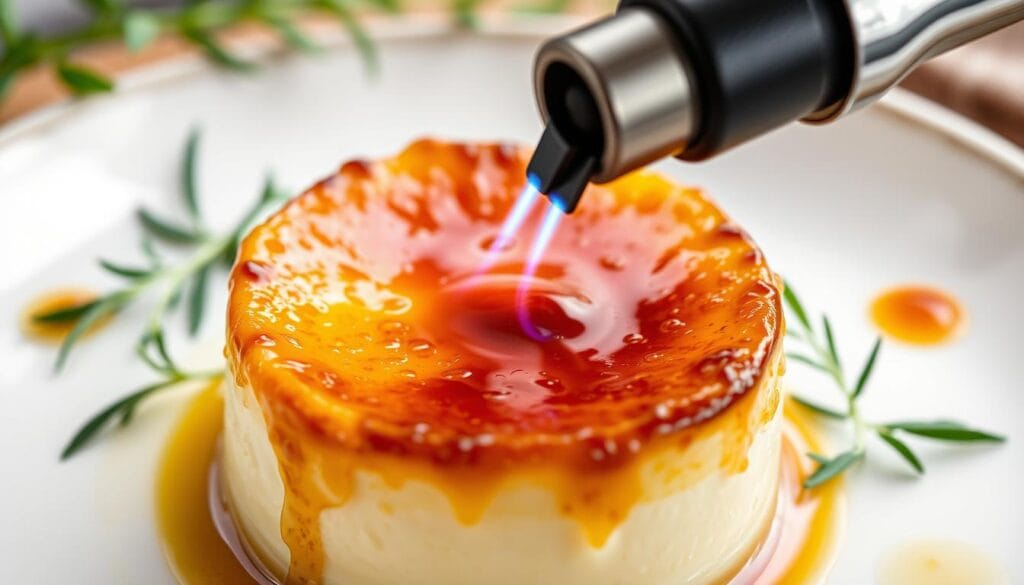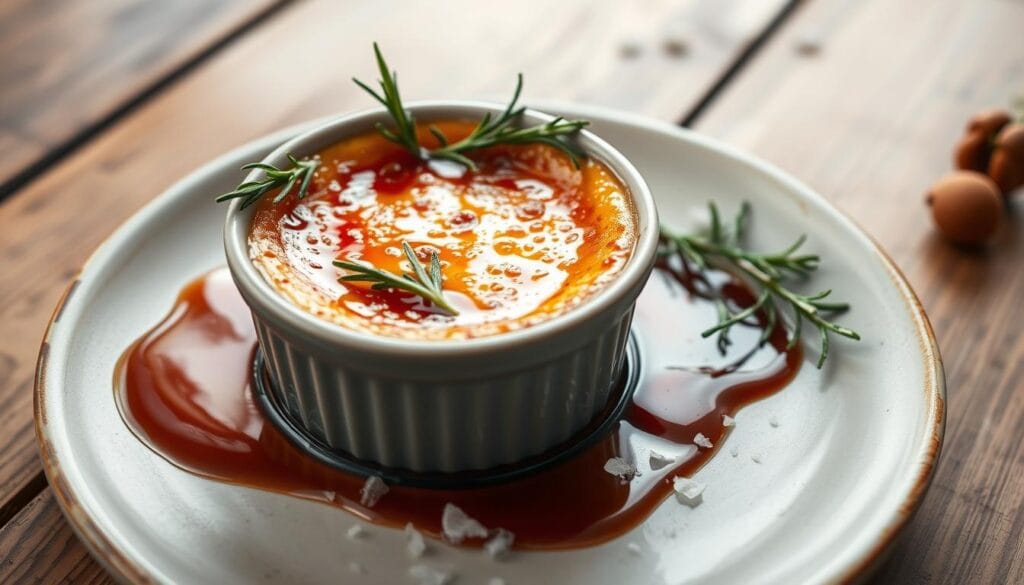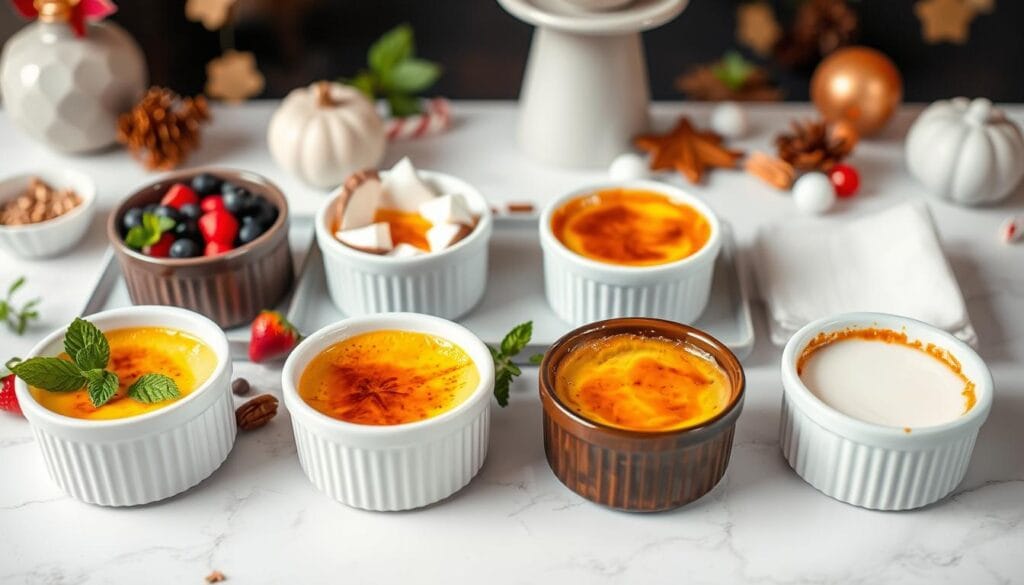
I love food, and crème brûlée is a favorite of mine. Its creamy texture and caramelized top are amazing. But, did you know you can make it savory? This French dessert can be a whole new dish.

Key Takeaways
- Savory crème brûlée is a unique twist on the classic French dessert, transforming it into an appetizer or main course. If you’re interested in other savory dishes, you might want to check out our Smoked Cream Cheese Recipe for a great appetizer.
- The creation process involves infusing cream with savory elements, creating a silky custard base, and finishing with a caramelized sugar top. For more on perfecting dishes like this, read our 5 Secrets to Perfect Crab Brûlée.
- Savory crème brûlée can be made with a variety of ingredients like crab, corn, or herbs to achieve different flavor profiles. If you enjoy seafood, our King Crab Brûlée could be a perfect alternative.
- Mastering the art of savory crème brûlée requires techniques like temperature control and achieving the perfect custard consistency. For those keen on perfecting other dishes, our Brown Gravy Smoked Sausage Recipe might interest you.
- Savory crème brûlée can be paired with a range of dishes, from seafood to vegetables, for a harmonious and delightful dining experience. Explore our Dinner Recipes for more meal ideas that complement your savory creations.
Table of Contents
Understanding the Art of Savory Crème Brûlée
Crème brûlée, a French dessert, is loved for its creamy custard and caramelized sugar. Now, savory versions are gaining fans. These dishes mix umami-rich ingredients with classic flavors, offering a unique taste and texture. You can learn more about the history of crème brûlée on Wikipedia.
Origins and Evolution of Traditional Crème Brûlée
The story of crème brûlée starts in late 17th century France. It was a sweet treat, made with cream, egg yolks, and caramelized sugar. Chefs and cooks later tweaked the recipe, adding their own twists.
The Transition from Sweet to Savory
Turning crème brûlée savory means choosing the right ingredients. Adding seafood, veggies, and cheeses gives it a new taste. The result is a mix of creamy custard, savory flavors, and a sweet caramel crust.
Key Components of Savory Variations
For savory crème brûlée, picking the right ingredients is key. The custard gets savory flavors from herbs, spices, or roasted veggies. The caramelized sugar on top adds sweetness and texture. For further reading on this classic dish, refer to the Crème Brûlée Wikipedia article.
It has opened up new culinary paths. It lets chefs and cooks get creative with a classic dessert. This shift from sweet to savory has made crème brûlée even more versatile and exciting.
Essential Equipment and Ingredients for Perfect Results
To make the perfect dish, you need the right tools and ingredients. You’ll need ramekins, a deep roasting pan, and a kitchen torch or broiler. These are for caramelizing the sugar topping. Also, use heavy cream, egg yolks, and savory ingredients like crab meat, corn, or herbs. For another fun dish, try our Crab Brûlée Recipe.
A vanilla bean can add depth and complexity to the custard. Fresh, high-quality ingredients are key for the best flavor and texture in your savory crème brûlée or crab brulee recipe.
- Ramekins: 6-ounce sized ramekins work best for even cooking and caramelization.
- Deep Roasting Pan: This will be used as a water bath to ensure gentle, even baking of the custards.
- Kitchen Torch or Broiler: For caramelizing the sugar topping, creating that signature crisp, golden brown crust.
- Heavy Cream: Provides a rich, creamy base for the custard.
- Egg Yolks: Essential for creating a silky, smooth texture.
- Savory Elements: Crab meat, corn, herbs, or other savory ingredients to complement the custard.
- Vanilla Bean: Adds depth and complexity to the flavor profile.
With the right tools and high-quality ingredients, you’ll be well on your way to mastering the art of savory crème brûlée.
The Science Behind Creating Silky Smooth Custard Base
Making the perfect king crab brulee or easy crab brulee recipe needs a good grasp of custard base science. It’s all about temperature control and technique. These steps ensure the custard is smooth and doesn’t curdle or get lumpy.
Temperature Control Techniques
To get a velvety custard, you must manage the temperature well. Start by slowly adding hot cream to eggs while whisking. This prevents curdling. Then, bake the custard in a water bath at 325°F (163°C) for 40-45 minutes. This gentle heat helps it set right without overcooking.
Achieving the Perfect Consistency
Getting the custard just right is a fine art. It should be firm but still jiggle a bit, like set Jello. Strain the mixture to make it smoother. This removes any lumps or impurities for a silky finish.
Preventing Common Custard Issues
- Curdling: Proper tempering of the eggs and maintaining a consistent baking temperature are crucial to prevent the custard from curdling.
- Crystallization: Using the right type of sugar, such as superfine sugar, can help minimize sugar crystallization for a seamless caramelized topping.
- Overcooking: Careful monitoring of the baking time and temperature is essential to avoid a dry, overcooked custard.
Mastering the science of a silky custard base can take your king crab brulee or easy crab brulee recipe to the next level. It offers a rich, smooth taste and a beautiful presentation.
Mastering the Caramelization Process
The caramelization process is key to making the perfect savory crème brûlée. First, a thin layer of granulated sugar is sprinkled over chilled custard. Then, a kitchen torch is used to melt and caramelize the sugar, held 1-2 inches away. This step creates a crunchy top that contrasts with the smooth custard below.
To get the caramelization just right, you need to be careful and precise. The sugar should melt and turn golden brown, adding a rich flavor to the creamy base. It’s important to move the torch in a steady circle to heat evenly and avoid hot spots.

If you don’t have a kitchen torch, you can use the broiler. But, you must watch it closely to avoid burning. The custard needs to be completely chilled and firm before broiling for the best results.
Trying different sugars, like Demerara or Muscovado, can bring unique flavors and textures to the caramel. The goal is to find the perfect balance between sweet caramel and savory best crab brulee recipe elements.
Mastering caramelization is the final step to an outstanding savory crème brûlée. With the right techniques and a bit of practice, you can get a golden, crunchy topping that complements the creamy custard perfectly.
Classic Savory Flavor Combinations
Take your cooking to the next level with savory crème brûlée. This dessert is not just for sweets. It’s perfect for seafood, herbs, vegetables, and cheese too. Discover the joy of mixing these flavors.
Seafood and Herb Infusions
Try crab crème brûlée for a unique taste. The sweet custard goes well with the salty crab. Add herbs like dill or chives for a great mix. Lobster adds luxury and flavor to the dish.
Vegetable and Cheese Pairings
Use corn for a veggie twist in your king crab brulee. The custard is a perfect base for this sweet and savory mix. Cheese lovers will enjoy the rich flavors of Parmesan or Gruyère.
Don’t be afraid to try new things with savory crème brûlée. Add spices like cinnamon or nutmeg for depth. A bit of honey can also add a sweet touch. There’s so much to explore and create in the world of crème brûlées.
Advanced Techniques for Texture and Presentation
Take your recipe to the next level. Learn how to make the custard ultra-smooth and look amazing with these tips.
For a silky texture, use an immersion blender. Blend in ingredients like corn into the custard base. This keeps it creamy and smooth, avoiding any lumps.
Adding garnishes can make your easy crab brulee recipe or best crab brulee recipe even better. Try adding torched corn kernels for a smoky flavor or a drizzle of maple syrup for sweetness.
The serving temperature is key. It should be chilled but not too cold. This keeps the custard creamy and luxurious.
“The secret to a perfect savory crème brûlée lies in the details. From blending techniques to temperature control, each step can elevate the final dish to new heights of indulgence.”

Mastering these techniques can turn your easy crab brulee recipe or best crab brulee recipe into a stunning dessert. Play with garnishes, flavors, and temperatures to create your own unique savory crème brûlée.
Troubleshooting Common Savory Crème Brûlée Challenges
Making the perfect savory crème brûlée is a delicate art. It can face challenges like curdled custards and sugar issues. But don’t worry, we have the answers to your biggest problems. Want to troubleshoot other recipes? Check out our Easy Crab Brûlée Recipe for more helpful tips.
Fixing Curdled Custards
Don’t panic if your custard curdles. This problem can often be fixed with patience and attention. Start by straining the mixture to remove any lumps. Then, heat it gently until it’s smooth again.
If the curdling is bad, it’s best to start over. This way, you can ensure your custard is silky and velvety.
Addressing Sugar Crystallization Issues
The golden caramelized sugar topping is key to a great savory crème brûlée. But sugar crystals can ruin it. To prevent this, apply a thin, even layer of sugar on top.
When caramelizing, use a kitchen torch for a smooth golden crust. If using the broiler, watch closely to avoid burning the sugar.
Remember, a little mistake can ruin a savory crème brûlée. But with some troubleshooting and passion, you’ll master this dish.
Seasonal Variations and Ingredient Substitutions
Savory crème brûlée is a versatile dish that can be changed with the seasons. You can add unique twists to this classic dish. Whether it’s summer, autumn, or any other time, there are many ways to make it special.
For a summer twist, add fresh corn to your king crab brulee recipe. The sweet corn goes well with the rich custard. Or, try a pumpkin-infused easy crab brulee recipe for autumn. It brings warm spices and a velvety texture, perfect for the season.
Want something exotic? Use pandan leaves instead of vanilla for a green custard with a unique aroma. This Southeast Asian twist adds a fascinating complexity to your dish.
Feel free to substitute ingredients for convenience. Use canned corn or whole milk instead of cream. Just remember to keep the balance and texture right.
“Seasonal ingredients and creative substitutions can breathe new life into the beloved savory crème brûlée, allowing you to explore a world of flavors and textures.”
Whatever twist you choose, the most important thing is to have fun. Let your creativity shine and find your own special way to enjoy this dish.

Pairing and Serving Suggestions
Enjoying the best savory crème brûlée means balancing its creamy texture with light flavors. It pairs well with grilled meats and fresh salads.
Try serving your savory crème brûlée with a grilled chicken breast. Top it with pesto and peach slices. This mix of flavors and textures is perfect for a meal.
For a casual option, pair your savory crème brûlée with a caprese sandwich. It has tomatoes, mozzarella, and basil. This combo is delicious.
If you like sweet treats, try a glass of Sauternes or Tokaji with your dish.
Always serve the savory crème brûlée right after caramelizing the sugar. This ensures the best contrast between the crunchy top and the smooth custard.
The savory crème brûlée can be made up to 3 days ahead. But, do the caramelization just before serving for the best texture and look.
Conclusion
Savory crème brûlée brings a new twist to the classic French dessert. It’s all about mastering custard making, flavor infusion, and caramelizing. This lets you create amazing dishes with seafood, veggies, or special seasonings.
It’s perfect for both everyday meals and special events. The right baking temperature is 300°F (150°C). And, leftovers of crab brulee can be stored for up to two days.
Pay attention to the details to make this dish shine. Focus on the right ingredients, cooking methods, and how you present it. This way, you can create unforgettable meals that impress your guests.
Keep exploring savory crème brûlée to make your own unique dishes. With attention to balance, texture, and flavor, you can turn simple meals into amazing experiences. Your creations will surely make a lasting impression.
If you’re interested in learning more about the history and origins of crème brûlée, feel free to check out the Wikipedia article on Crème Brûlée.
FAQ
What is savory crème brûlée?
Savory crème brûlée is a twist on the classic French dessert. It turns into a tasty appetizer or main dish. It mixes creamy texture with savory tastes, like crab, corn, or herbs.
How does savory crème brûlée differ from the traditional sweet version?
Savory versions use seafood, veggies, and cheeses instead of sweet ones. They have a rich custard base with savory flavors. The caramelized sugar topping adds a nice contrast.
What equipment is needed to make savory crème brûlée?
You’ll need ramekins, a deep roasting pan, and a torch or broiler. Heavy cream, egg yolks, and savory ingredients like crab or herbs are key.
How do you create a smooth custard base for savory crème brûlée?
To make a smooth custard, control the temperature and technique. Whisk eggs slowly into hot cream to avoid curdling. Bake in a water bath at 325°F (163°C) for 40-45 minutes.
What is the process for achieving the caramelized top?
To get the crunchy top, sprinkle sugar on the custard. Use a torch to melt and caramelize it, or a broiler with care to avoid burning.
What are some popular savory flavor combinations for crème brûlée?
Seafood like crab or lobster with herbs like dill is popular. Corn and cheese-based versions also offer sweet and savory tastes.
How can you enhance the texture and presentation of savory crème brûlée?
Use an immersion blender for smooth custard. Garnish with torched corn or maple syrup for extra flavor and look.
What are some common challenges in making savory crème brûlée?
Curdled custards and sugar crystallization are common issues. Strain or start over for curdled custards. Ensure even sugar and proper torch use for crystallization.
Can you create seasonal variations of savory crème brûlée?
Yes, use fresh corn in summer or pumpkin in autumn. Pandan leaves add a unique flavor for a Southeast Asian twist.
What are some suitable pairings for savory crème brûlée?
Pair it with light dishes to balance its richness. Try grilled chicken with pesto or caprese sandwiches.


1 thought on “Savory Crème Brûlée: How to Add a Touch to Your Favorite Dish”